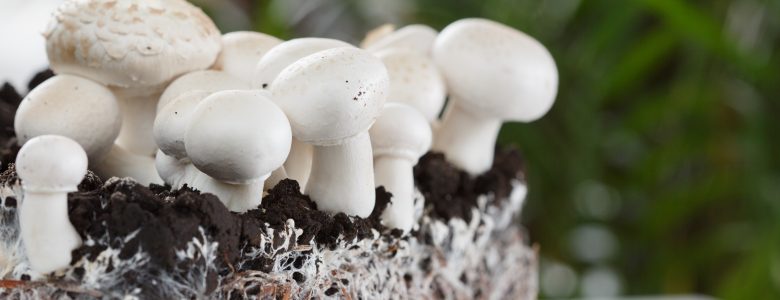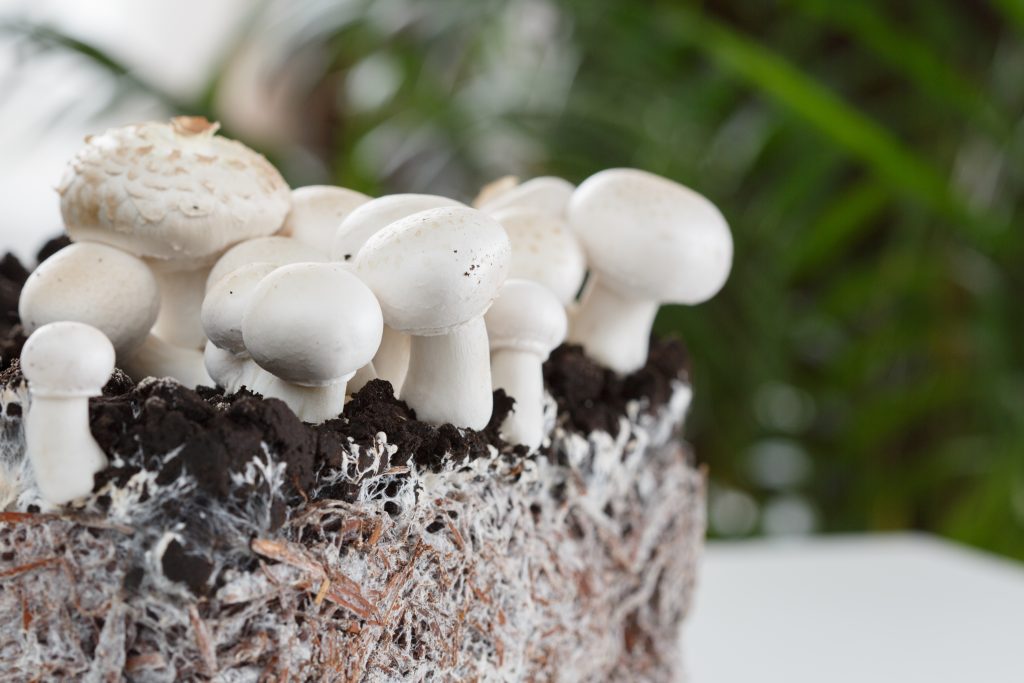May 18, 2020
Mycelium: Man’s Unexpected Best Friend

By: burgundy bug
Homemade champignon mushrooms and mycelium growing
Source: Adobe Stock
Red speckles and poofy, majestical shapes that appear to be pulled straight from a fairy tale are most likely at the forefront of your mind when you think of mushrooms – or, perhaps, some colorful, swirly-whirly imagery and “hippie babble” come to mind.
But there’s far more to mushrooms than meets the eye. Mycelium, the vegetative part of fungi that forms during the hyphae growth stage of mushrooms, has piqued the interests of researchers around the globe.
In recent years, scientists have put mycelium under the microscope due to its physical strength and pharmacological properties. This has opened the floodgates for mycelia to serve as a natural construction compound for building houses or creating new medicines.
What is mycelium?
Source: What is Mushroom Mycelium? | Host Defense Mushrooms
Mycelium in Construction
“Mycelium has a filamentous network structure with mechanics largely controlled by filament elasticity and branching, network density… The material exhibits considerable strain hardening before rupture under tension.”
MORPHOLOGY AND MECHANICS OF FUNGAL MYCELIUM in Scientific Reports
According to a 2020 Materials & Design study, mycelium displays the potential to replace “foam, timber, plastic insulation, door cores, panels, flooring, and furnishings.”
Mycelium is low in density, it’s fire-resistant, high in sound absorption, cost-effective, and environmentally sustainable.
Due to these properties “outperforming traditional construction materials, such as synthetic foams and engineered woods, they show particular promise as thermal and acoustic insulation foams.”
However, mycelium may serve better as a structural supplement for more specific applications because of their foam-like structure and highly water-absorbent properties, the study explains.
Nevertheless, traditional construction materials are highly unsustainable; their production consumes energy and limited natural resources, while simultaneously polluting the environment.
Even low-energy buildings have a negative environmental impact due to how much energy it takes to manufacture the insulation and other technologies utilized to make them “eco-friendly,” the study continues.
“Mycelium-derived materials have several key advantages over traditional synthetic materials including their low cost, density, and energy consumption in addition to their biodegradability, low environmental impact, and carbon footprint,” the study says.
Such properties have garnered the attention of NASA in construction projects beyond our horizon. Earlier this year, NASA said they were exploring technologies to grow structures out of fungi to “become our future homes in the stars, and perhaps lead to more sustainable ways of living on Earth as well.”
Read: Moonshrooms: How Fungi Could Shape Life on Mars
The Burgundy Zine
Mycelium in Medicine
“Mushroom mycelium are considered as nutraceuticals and pharmaceuticals, convenient to grow, more nutritious, and therapeutically stronger.”
Medicinal importance of mushroom mycelium: Mechanisms and applications in Journal of Functional Foods
Mycelium in Treating MRSA
Before the discovery of penicillin in 1928, molds were widely used to treat infected wounds, according to a 2015 Saudi Journal of Biological Sciences study.
“Imhotep, an ancient Egyptian practitioner, for example, used moldy bread to treat infections of the face,” the study says. “The literature from more recent folk medicine has documented some examples of the use of molds on infections. For example, moldy jam and bread were widely used in folk-based therapy in Quebec (Canada), Devon (United Kingdom), and Kansas (USA) and poultices made from moldy chewed barley and apple have long been used in Asia to cure surface wounds.”
However, throwing mold into an open wound without knowing what other compounds are in it could potentially pour gasoline over the fire. There are some strains of penicillium that produce potentially dangerous mycotoxins, like patulin. Long term patulin intake has been linked to the formation of cancers.
Another penicillin related antibiotic is Methicillin, which had been developed in the mid-20th century to treat staph infections, reports Medicine Net.
But MRSA is a methicillin-resistant strain of staph that is among one of the Centers for Disease Control and Prevention’s top antibiotic resistance threats in the United States. According to an article by Scitable, MRSA evolves at such rapid rates, doctors are left to treat it with “last-resort” methods or newer antibiotics.
There are very few antibacterial compounds that MRSA isn’t already resistant to – and some of them are found in the mycelia of fungus cultivated from moldy fruit, the 2015 Saudi Journal of Biological Sciences demonstrates.
After isolating strains of penicillium from moldy fruit and fungi, the researchers found strains that inhibited both MRSA and MSSA (methicillin-susceptible staph. aureus).
Although the study concludes by questioning when it might be useful to obtain penicillin from moldy produce, it does suggest it could be useful in “extreme conditions” where medical intervention isn’t possible (i.e. “after a nuclear war, or during local extreme living conditions such as in prisoner of war camps”).
That being said, if you believe you may have contracted MRSA, contact your doctor immediately. If left untreated, the CDC says MRSA infections can be fatal.
And as mentioned above, rubbing moldy food into an infection is akin to playing Russian roulette with mycotoxins and potentially other unknown compounds.
Mycelium and Depression
The rare edible Lion’s Mane Mushroom (Hericium Erinaceus) in the Forest. Beautifully radiant and striking with its white color between autumn leaves and the green moss Photographed on the Veluwe at the leuvenum forest in the Netherlands
Source: Adobe Stock
“Depression is a common and severe neuropsychiatric disorder that is one of the leading causes of global disease burden,” says a 2020 International Journal of Molecular Sciences review. “Although various antidepressants are currently available, their efficacies have been barely adequate and many have side effects. Hercilium erinaceus, also known as Lion’s mane mushroom, has been shown to have various health benefits, including antioxidative, antidiabetic, anticancer, anti-inflammatory, antimicrobial, antihyperglycemic, and hypolipidemic effects.”
Compounds found within the fruiting body and the mycelia of Lion’s mane mushrooms are associated with nerve growth factor, which is involved in the growth, survival, and developmental plasticity of neurons.
Although current research on the treatment of depression with Lion’s mane mushroom is still “in its early stages,” the preclinical animal studies and clinical studies in human adults highlighted throughout the review demonstrate how these compounds alleviate symptoms of depression.
Various Lion’s mane mushroom compounds are involved in monoaminergic modulation, which targets neurotransmitter depletions associated with depression: serotonin, norepinephrine, and dopamine.
Read: The Role of Serotonin in Your Daily Life
The Burgundy Zine
Depression has also been associated with inflammation and the inability to adapt or respond to adverse stimuli due to negative regulation of neurogenesis. Lion’s mane mushrooms have demonstrated positive effects on neurogenesis in treating cognitive impairment, Parkinson’s Disease, Alzheimer’s Disease, and reinvigorated neurogenesis in stressed in animals.
It’s worth noting that many of these studies didn’t have a placebo or control group. Throughout the review, the authors suggest various methods to improve the scope of future research on these compounds.
Mycelium and Cancer
“Epidemiological studies conducted in Asia suggest that mushroom intake, together with other phytotherapy substances, protects against cancer, specifically gastrointestinal and breast cancers.”
B-glucans from Grifola frondosa and Ganoderma lucidum in breast cancer: an example of complementary and integrative medicine. | Oncotarget
“Medicinal mushrooms have been used for hundreds of years, mainly in Asian countries, for the treatment of infections,” says a 2018 Oncotarget review. “More recently, they have also been used in the treatment of pulmonary disease and cancer.”
Mushrooms have been approved as an additional part of cancer treatment in Japan and China for over three decades, the study continues. The anticancer and antitumor properties of medicinal mushrooms mainly stem from their effects on the immune system.
Ganoderma lucidum (reishi mushrooms) and grifola frondosa (maitake mushrooms) are particularly associated with targeting cancer cells. While clinical trials on these mushrooms are limited, the evidence thus far shows promise in their co-treatment of several cancers.
“The most important preclinical studies of anticancer effects of maitake were performed to evaluate MD-fraction activities,” the review states.
These MD-fraction activities have direct antitumor activity on the adenocarcinoma cells of mice, which are cancer found in mucus-producing gland cells.
“The antitumor effects of MD-fraction have mainly been attributed to its immunostimulatory capabilities, as previously reported, as well as to direct antiproliferative [inhibiting cell growth] and cytotoxic [toxic to cells] effects in human cancer cells, including prostate, bladder, liver, brain, blood, and breast cells,” the review says.
Maitake mushroom powder may also have the potential to reduce the size of lung, liver, and breast cancer.
“Cancer regression or significant symptom improvement was observed in 58.3 percent of liver cancer patients, 68.8 percent of BC [breast cancer] patients, and 62.5 percent of lung cancer patients,” the review says.
Furthermore, mushrooms contain minerals, vitamins, amino acids, and other nutrients that contribute to overall health benefits. Their anti-inflammatory, antiallergic, antioxidant, antibacterial, and liver-protective properties also improve a patient’s quality of life.
The researchers don’t recommend relying on mushrooms alone for cancer treatment. Rather, they advise using it in conjunction with other treatments, like chemotherapy or radiotherapy.
“Therapeutic approaches that incorporate g. lucidum [reishi mushrooms] are 1.25 times more likely to yield better tumor responses than those [that] do not,” the review concludes. “Further, g. lucidum preparations can be administered in order to counter the immunosuppressive effects of CT [chemotherapy] and RT [radiotherapy].”
Although the review discusses reishi and maitake mushrooms as a whole, rather than only focusing on their mycelia, the studies discussed distribute the mushrooms in a variety of forms: through water extract of reishi mycelium, maitake in powder form, incorporating these fungi into the patient’s diet, and so forth.
In Conclusion
Various uses for mushrooms that are currently being studied
Source: You Didn’t Know Mushrooms Could Do All This | National Geographic
“There are so many things you can do with fungi, this is what keeps us up at night,” says mushroom researcher Tradd Cotter in a 2016 National Geographic video. “Fungi for food, medicine, textiles, fiber, packaging materials, even biofuel. Fungi just have this potential to unlock biological material that’s a waste in our civilization and convert it into something else.”
Mushroom and mycelia in the natural world exhibit abilities that are unbelievable in their own right, such as enabling plant communication through common mycelial networks or breaking down environmental pollutants through bioremediation.
Read: How Plants Think: The Controversy of Consciousness
The Burgundy Zine
Mycelia’s strength, flexibility, and healing properties make it a viable prospect as an eco-friendly construction material or a versatile, natural alternative for treating a variety of conditions.
The mushroom boom is just beginning in the research field and the results so far warrant additional exploration. Future studies would not only grant us insight into how mushrooms work their magic, but they could give us another avenue to understand the biological mechanisms underlying an array of medical conditions and illnesses.
Interested in having content featured in an upcoming blog post or issue of The Burgundy Zine? Head on over to the submissions page!
Interested in working with Burgundy Bug? Learn more about commissioning her writing and art here!
For all other inquiries, please fulfill a contact form.



